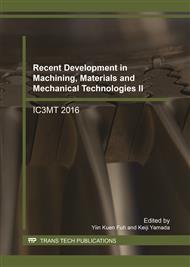p.118
p.124
p.130
p.136
p.141
p.148
p.154
p.161
p.171
Effects of Tool-Edge Form during the Drilling of CFRP
Abstract:
The drilling of carbon fiber reinforced plastics (CFRP) involves many problems such as an extremely short tool life or CFRP delamination occurring at the exit surface of drill. In an effort to solve these problems, this experiment observed the form of the drill’s tool edge. Then, an investigated the form of the tool edge with regard to low-cost, high-precision, and high-efficiency machining processes. The thrust direction of the cutting force is decreased as the CFRP delamination at the exit surface of drill is decreased. It is considered suppressing the delamination on the exit surface of drill by reducing the thrust force during drilling. In this experiment, the CFRP materials had a thickness of 4 mm. This experiment used sintered carbide, straight shank drill tooling with a diameter of 6 mm. Ten different types of straight shank drills with different point angles and coating treatment were tested. Additionally, this experiment an evaluated the cutting force, the cutting temperature, and the CFRP delamination at the exit surface of drill through the drilling and processing of 100 holes. Moreover, this experiment an evaluated the effects of chamfering of honing the tool edge with regard to the drilling and machinability of CFRP. This experiment used CFRP material with a thickness of 8 mm and four types of sintered carbide drills. As a result, the CFRP delamination distance of the exit surface of drill became smaller at point angles 130° and 140°. No differences in the cutting force or the cutting temperature were observed due to the different point angles. The results of the evaluation indicated that for the case without honing, the thrust force becomes 1/3 less than that for the case with honing of the drill tool. Additionally, in the case of without honing, CFRP delamination was suppressed at the exit surface of drill.
Info:
Periodical:
Pages:
141-147
Citation:
Online since:
August 2017
Authors:
Keywords:
Price:
Сopyright:
© 2017 Trans Tech Publications Ltd. All Rights Reserved
Share:
Citation:


